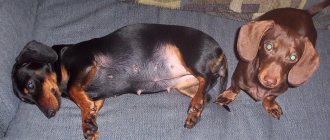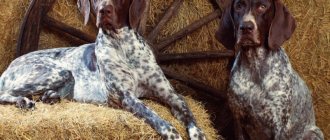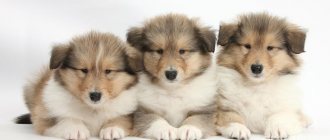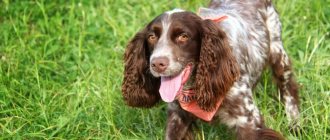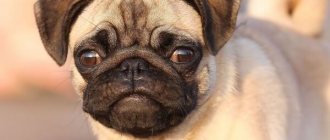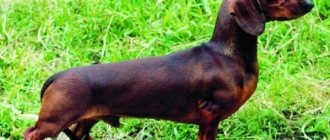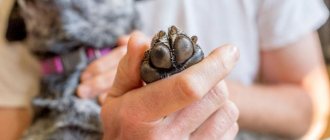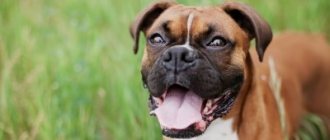Milk teeth in puppies
Puppies are born completely toothless. Up to 3-4 weeks, babies do not need teeth at all; the main food for growing pets is mother's breast milk or its substitutes when bottle-fed. The first milk teeth in puppies appear at 3-4 weeks of life; by 6-8 weeks of age, puppies should have 28-32 tiny sharp teeth in their mouths.
In small dogs, the timing of the eruption of the first teeth is slightly delayed compared to other breeds. The physiological process of the appearance of milk teeth in pets begins only at 6-7 weeks with the final formation of the dentition by 10-11 weeks of age.
Remember! The normal number of teeth in the mouth varies between breeds.
If by the age of 12 weeks the baby has erupted more or fewer teeth, taking into account breed characteristics, it is worth contacting a veterinarian. Such violations are fraught in the future with malocclusion and improper formation of the jaws, which lead to pathologies of the oral cavity and digestive tract. In addition, dental problems are a reason for lowering marks at exhibitions or disqualifying an animal.
In most dog breeds, the dentition of primary teeth consists of 28 teeth, 14 on each jaw: 2 canines, 6 incisors and 6 premolars.
- At the 3rd week of life, tiny sharp fangs erupt in the puppy.
- After 2 weeks, the incisors appear.
- The premolars are the last ones to emerge at 6-8 weeks of life.
To properly form the dentition and maintain the growing bone structure, your pet must receive calcium supplements daily. Symptoms of the onset of teeth change
In healthy puppies, the change of teeth most often occurs without complications. Baby teeth have fairly long roots that are absorbed under the pressure of the growing permanent tooth. Symptoms of the beginning of teeth change in puppies are characteristic changes in behavior: the dog begins to chew, tear, and grab the owners’ legs and arms.
These innocent pranks are caused by severe itching of the gums; the pet tries to relieve the painful sensations with the help of any object it comes across.
Important! Punishing, raising your voice or raising your hand at a puppy for spoiling objects is simply unacceptable.
A puppy is a small child whose gums simply itch unbearably. During the period of growth of permanent teeth, it is necessary to give the animal special toys or hard devices that can be safely chewed.
During the change of teeth, a decrease in immunity occurs in the body; during this period, hypothermia, changes in diet, heavy training, and active games with adult dogs should not be allowed.
Sometimes there may be a slight increase in temperature, lethargy, diarrhea and refusal to feed. If the puppy refuses to eat for several days, there is bad breath, diarrhea and depression, it is recommended to show the animal to a specialist.
In what order and at what months do puppies change teeth?
The beginning of the change of teeth starts almost immediately after the completion of the growth of milk teeth. Depending on the breed, food, and care rules, it is considered normal when this process is completed when the dog reaches one year of age.
Puppy milk teeth
The change of teeth occurs in stages, that is:
- first the incisors are replaced (3 months);
- then the fangs fall out (up to 7 months);
- premolars change.
Unlike the milk series, the permanent series is supplemented by molars. The first molars (M1) appear by 5 months, the second (M2) by 6 months, and the third (M3) by 7 months.
Scheme of changing baby teeth in puppies
At approximately 3-4 months, puppies begin to change their teeth. By this time, the small dog should undergo all preventive measures: deworming, treatment for external parasites and vaccination. The following veterinary procedures are carried out only after changing teeth in order to avoid the development of possible complications.
The owner of a growing dog is recommended to conduct a daily examination of the oral cavity from the age of 3 months to monitor the sequence of eruption of permanent teeth.
Knowing the pattern of replacement of baby teeth in puppies can be useful if deviations occur; in case of any changes or abnormal growth of teeth, it is recommended to consult a specialist.
- At 3-5 months, most dog breeds begin to change their incisors, first the animal loses the hooks, then the middle and edges fall out.
- Following the incisors, the first molars erupt at the age of 5-6 months.
- At six months, the puppy's molars emerge.
- The process of forming a permanent dentition is completed by sharp and fragile canines and massive molars, which erupt at 7-9 months.
- With proper growth and sequence of teeth, all dog breeds should have a full set of teeth by 10 months of age.
Most breeds of adult dogs have 42 permanent teeth in their mouths: 22 on the upper jaw and 20 on the lower jaw. The animal must have 4 canines, 10 molars, 12 incisors and 16 premolars.
If puppy teeth were snow-white, then for mature animals the norm is light yellow. A healthy dog should have a scissor bite. Any deviations in the number of permanent teeth and malocclusion are disqualifying defects.
Dental formula
So how many teeth does a dog have? Are there any differences from humans? Normally, an adult dog should have 42 teeth (20 on top and 22 on the bottom). Six incisors are located in front on the upper and lower jaws. They are used for biting food and have their own names. A pair of hooks are located in the center. Behind them come the middle incisors and even further - the edges.
Molars are used for chewing food. On the upper jaw there are 6 of them on the right and left, on the lower jaw - 7 on both sides. Three pairs of upper and four pairs of lower chewing teeth, located closer to the incisors, change. They are called false roots and are designated in the formula as premolars. The remaining chewing teeth, located on the edge (three pairs above and below), grow later than the milk teeth and are not replaced. They are called true molars and are formally designated as molars.
Between the incisors and molars are the fangs. There are only four of them: a pair at the top and at the bottom. The purpose of these teeth is to tear and grind hard food, demonstrate to intimidate the enemy, and use for defense and attack. When biting, it is the fang marks that are most noticeable on the body, as these teeth are longer than the others. In total, it turns out that there should be only 42 teeth in the dog’s mouth: 12 incisors, 4 canines, 26 molars.
How to help a puppy with teeth changes
Normally, as the permanent tooth grows, the root of the baby tooth is reabsorbed and removed. A new, strong molar grows in the vacated socket. But, unfortunately, the process of changing teeth does not always develop according to this scenario. If the root of a baby tooth does not resolve in time, a new tooth begins to grow sideways, in front or behind the main row. The result may be a double row of teeth – false polydentia, which can be removed surgically in a veterinary clinic.
To avoid malocclusion and improper jaw formation, the owner of a four-legged baby must know how to help the puppy when changing teeth. First of all, it is necessary to carefully examine the dog’s mouth every day, checking for the presence of milk teeth in accordance with the age of the animal. If the tooth has been sitting for a long time, a new permanent tooth is visible, the dog is a dwarf or narrow-muzzled breed, it is recommended to loosen the milk teeth with your fingers wrapped in sterile gauze.
It is best to carry out such manipulations in a playful way so that the pet does not defend itself. Loose incisors and premolars can be easily removed by sharply tilting them outward. Fangs are much more difficult to deal with. If independent measures do not bring results. It is recommended to consult a veterinary dentist.
Sometimes permanent teeth do not come out for a long time, this condition is called hypodontia. Violation of the formation of permanent dentition in hypodentia is caused by the formation of too thick a bone plate. Problems are solved promptly in a veterinary clinic by cutting the gums and periosteum after an X-ray examination.
At what age do dogs change their teeth?
At birth, the puppy has no teeth. The very first teeth begin to appear at the age of eleven to fourteen days. Do dogs lose their baby teeth? Certainly. A puppy, like a child, undergoes the process of loss of milk teeth and in this sense goes through the same stages of growing up as a person. When does a dog's baby teeth fall out? The gradual loss of baby teeth in puppies begins at three months. The duration of this process can range from two and a half to six months.
When do Dachshunds' baby teeth fall out? The dachshund's baby teeth begin to emerge in the fourth week of life. The peculiarity is that the fangs are the first to sprout. A dachshund's milk teeth are very fragile and fragile because they do not have roots. For this reason, already at 3.5–4 months of age, a gradual process of replacing baby teeth with permanent ones occurs. Dachshunds usually develop permanent teeth by 6–8 months of age. True, already in the first stages a problem with the dental cavity may arise: if the milk teeth have grown too tightly to the gums, then it often becomes difficult for old teeth to fall out and new teeth to begin to grow. The situation that has arisen is fraught with the following consequences: serious oral diseases develop.
The main symptoms are drooling, bad breath, and lack of appetite. The most common and frequently encountered diseases in practice are:
- Stomatitis is an inflammation of the oral mucosa. The main reasons for the development of this disease are dental caries, changing teeth, and tartar. Signs of stomatitis include: copious secretion of thick and viscous saliva, coating on the mucous membrane and tongue, unpleasant odor, coating on the tongue.
- Gingivitis is an inflammation of the gums that occurs due to the adverse effects of local and general factors. Local factors for the development of gingivitis include: low level of oral hygiene, resulting in the formation of dental plaque and malocclusion. General factors: pathology of the digestive tract, hormonal disorders, blood diseases.
- Periodontitis is an inflammatory disease of periodontal tissues, characterized by the progressive destruction of the normal structure of the alveolar process of the jaw, inflammation of problems with the roots of the teeth, and their serious diseases. It is formed due to hard dental plaque. The presence of this disease in a pet can be determined by the following characteristic signs: excessive bleeding of the gums, viscous saliva, tooth decay, and a strong unpleasant odor. Periodontitis leads to loosening of teeth and their subsequent loss. This disease occurs for two reasons: either it is a hereditary predisposition, or a consequence of poor nutrition. Therefore, it is necessary to give the dog food that he can gnaw or chew for a long time. It is more difficult to treat than ordinary tartar. Treatment includes antibiotic therapy; regular, fairly frequent local treatment of the oral cavity is necessary.
Problems with the oral cavity are also reflected in the roots of the dog’s teeth. Due to heavy plaque and large deposits of tartar, the infection penetrates the gums, resulting in periodontal inflammation, the dog’s teeth fall out, and tooth roots are destroyed.
Therefore, owners should not lose sight of the possibility of this problem occurring. You need to be on guard from the very beginning, when the puppy is just brought home.
What can you give your puppy to chew during the teething period?
Over the course of 4-5 months, while the teeth are changing, due to constant itching, the puppy can chew off all soft and hard furniture, curtains, shoes, books and anything else it comes across. To save the apartment, the nervous system of the owners and alleviate the unpleasant symptoms of the animal, it is recommended to give the animal special devices on which the dog can scratch its swollen gums.
What can you give your puppy to chew during the teething period?
- Toys. You can purchase special toys for puppies that make teething easier. An alternative to them can be ordinary children's toys made of thick rubber or balls.
- Delicacies made from ox veins are an excellent alternative to meat bones and a good object for massaging the gums. Bones from bovine veins are selected taking into account the breed, so that the baby can study it for as long as possible. The composition of a functional toy is very important; ideally, the bone should be a natural yellow color and not contain dyes or preservatives that are dangerous to the baby’s health.
- Vegetables and fruits. An excellent vitamin toy for a puppy can be a green apple, a pear, a raw carrot, a cabbage stalk, or a beet slice. The size of the vegetable is selected according to the size of the pet’s mouth.
- Sugar beef bones and cartilage. Natural meat products must be thoroughly washed and scalded with boiling water before serving.
Wooden toys or sticks are not recommended due to the risk of splinters and ingestion of splinters.
Similar recommendations apply to rag toys; the animal will tear them into pieces in no time and swallow pieces of fabric. You should not allow your dog to play with stones, metal or sharp objects to avoid damaging the oral mucosa and fragile dog teeth.
Possible complications in puppies during the period of teeth change
If the process of changing teeth occurs in the correct sequence and the small pet is in normal health, the owner can only control the order of appearance of new permanent teeth and provide the nimble tomboy with toys - chewing toys. But not all pets go so smoothly. Quite often, disorders or complications arise that can lead to pathologies or improper formation of the jaw.
Gum inflammation
A slight inflammatory process during the period of tooth change is observed in all animals, but with reduced immunity and insufficient nutrition, pathogenic microflora multiply and gingivitis develops. With pathology, the animal's gums are very swollen and red, there is an unpleasant odor from the mouth and profuse salivation, sometimes with blood.
Persistent teeth
Violation of the formation of the dentition occurs when the removal of a baby tooth is delayed due to heredity, improper feeding or lack of calcium in the dog’s diet.
In the oral cavity, along with the molars, there are also milk teeth, sometimes two teeth stick out from one hole. Solving the problem at home comes down to loosening a baby tooth.
Diarrhea
The proliferation of putrefactive microflora in the intestines with the development of diarrhea is due to a decrease in immunity due to the change of teeth. Diarrhea occurs as frequent loose stools with an unpleasant odor. To avoid dehydration if diarrhea lasts more than 24 hours, it is recommended to give the animal a decoction of rice; you can also give enzymes and probiotics.
Smell from the mouth
Bad breath during puppyhood may be a symptom of gum disease, dental disease, or internal organ disease. If, in addition to the disgusting odor, there is food refusal, lethargy or loose stools, you should take your pet to a veterinarian.
Poor appetite
Changing teeth always causes a decrease in immunity, general weakness and refusal to feed. If your pet does not eat well, you should try to feed him pureed food from a syringe.
How to care for dachshund ears
Dachshund ears are cleaned no more than once a month. Wrap a damp cotton pad around your finger and carefully rub all the folds on the inside of the ear. Instead of water, you can use baby oil for wiping.
It is better not to use a cotton swab - the dog may twitch and injure the ear. If the auricle is very dirty or there is discharge with an unpleasant odor, you should be wary. Such signs may indicate an inflammatory process. In this case, the disc is moistened with Anadin drops, and after wiping the ear, 3 drops of the same drug are instilled into it. This procedure is carried out 2 times a day for a week.
Types of bite and its disorders
In puppies, before they reach 4 months of age, it is almost impossible to determine the correct bite. A pet with an incorrect bite may lose a brilliant career and breeding work.
Main types of bite
- Scissor-shaped. It is a physiological norm for most breeds; with the correct bite, a kind of lock is formed when the jaws are closed. An indicator of correct bite is the contact of the lower incisors with the base of the back of the upper incisors.
- Straight bite is an incorrect closing of the jaws, in which the incisors close straight, in one line, and the canines and chewing teeth do not completely connect. This type of bite leads to rapid wear of the incisors and digestive disorders.
- Overbite is a normal physiological bite for Bulldogs, Boxers, Pekingese and Shih Tzus, in which the lower incisors and canines protrude slightly forward. The presence of an overbite in other dog breeds is considered a developmental defect.
- Underbite – the upper incisors protrude strongly in relation to the lower incisors; such an overbite is considered a disqualifying sign.
Malocclusions include the following developmental anomalies:
- Polydentia is the presence of extra teeth with persistent teeth.
- Hypodentia or oligodontia – insufficient number of teeth;
- Crossbite is when the lower incisors overlap the upper incisors when the jaws are closed.
- Misalignment of the bite is caused by improper formation of the jaw box due to the accelerated growth of one side of the jaw.
- An open bite is a developmental anomaly in which the incisors do not close at all.
Improper closing of the jaws leads to pathologies of the oral cavity and digestive tract. In addition, dogs with malocclusion are disqualified from competitions and exhibitions and are not allowed to be bred. You can correct a bite in puppyhood with the help of braces; after 12 months, no medical manipulation will bring the desired result.
Feeding a puppy during the teething period
The formation of permanent dentition is accompanied by the leaching of calcium from the bones and a general decrease in immunity, so great attention is paid to the issue of feeding puppies during the period of teeth change. You should not change the animal’s diet during this period; all new products according to age should be added gradually, taking into account the age of the animal.
Basic rules for feeding a puppy during the teething period
- your pet should receive fermented milk products every day: cottage cheese, kefir, yogurt, calcined cottage cheese;
- Be sure to include calcium-containing supplements and vitamins in your dog’s diet;
- when feeding natural products, it is useful to give the dog large pieces of raw meat to strengthen the jaw during chewing;
- dry food is given unsoaked;
- the puppy must receive raw vegetables and fruits that can be chewed: apples, pears, carrots, beets, cabbage;
- Before going to bed, you can treat your pet to a large sugar beef bone;
- special treats are good for teeth: bones from ox veins and crackers;
- with natural feeding, the pet should consume 50% protein food per day - raw meat, boiled fish, offal, eggs, dairy products;
- the rest of the diet - cereals, vegetables, fruits, additives, herbs, vegetable oil, nuts, seaweed, rye flour, bran;
- It is not allowed to feed the dog very hard food to avoid injury to the gums and fragile permanent teeth.
Vaccinations during teething changes
A fairly common question among puppy owners is whether it is possible to get vaccinations during teething. The formation of permanent dentition in dogs begins no earlier than 3-4 months, in small and dwarf breeds - even later. This physiological process is accompanied by a sharp decrease in immunity, which, in the absence of vaccinations in the event of illness, can lead to a rapid course of pathology and death.
From birth, puppies receive colostral immunity through their mother's breast milk, but by 2-3 months the amount of antibodies in the blood of small dogs decreases sharply. According to the modern vaccination schedule, in a favorable epizootic situation, the first vaccinations are given at 2 months of age with revaccination after 3-4 weeks . By the time the puppy changes its teeth, it should be dewormed three times at the appropriate times and treated for external parasites.
At 3 months, the dog must be vaccinated against canine distemper, infectious hepatitis, parvovirus enteritis, parainfluenza and leptospirosis. Rabies vaccination is carried out no earlier than 6 months. Veterinary experts do not recommend vaccinations during teething to avoid the risk of complications.
The exception is outbreaks of infectious diseases for which the animal has not had time to be vaccinated. If the puppy has not received any vaccinations by the time the teeth change, it is necessary to get vaccinated after a complete examination of the animal by a doctor. Modern vaccines have virtually no side effects and do not cause complications.
If forced vaccination was carried out during the period of teeth change, the owner must monitor the condition of the pet daily and, if necessary, consult a doctor.
Caring for the puppy during this period
- When changing teeth, it’s a good idea to add foods that contain calcium and phosphorus to your main diet;
- It is also worth giving puppies large pieces of meat - in the process of absorbing it, the teeth self-clean;
- it is necessary to frequently monitor the bite so that permanent teeth do not begin to grow before the old milk teeth fall out;
- be sure to contact a veterinarian if you notice the slightest deviation from the norm when changing teeth in the animal’s oral cavity;
- You should not play tug-of-war with puppies who are in a state of changing chewing elements, or forcefully pull toys out of their mouths - there is a very high probability of malocclusion and loosening of baby teeth;
- if baby teeth do not fall out at the appointed time, then discuss their removal with a specialist (careful loosening of baby teeth with your fingers is allowed, especially in dwarf breeds);
- Make sure that your pet does not chew on hard toys to avoid the loss of baby teeth and injury to the gums.
If you have additional tips for caring for your pet while replacing the milk line with a permanent one, then share your experience in the comments.
Dental care for puppies
From an early age, it is recommended to accustom small pets to hygienic procedures so that an adult animal is calm about all manipulations. Dental care for puppies is the key to good oral health and internal organs.
Basic rules for proper puppy dental care
- daily brushing of baby or permanent teeth with a children's toothbrush using veterinary toothpastes;
- sanitation of the oral cavity with antibacterial gel;
- use of functional treats containing disinfectants and bovine bones;
- feeding the animal with rough and solid food: raw meat, vegetables, fruits;
- mandatory introduction of fermented milk products and calcium-containing preparations into the diet;
- examination of the oral cavity for damage and inflammation.
It is forbidden to pull objects and food from the mouths of growing dogs, play tug of war, or give hard, sharp or metal objects.
If you experience an unpleasant odor from the oral cavity, excessive salivation, swollen gums, or ulceration of the mucous membrane, it is recommended to immediately seek help from a specialist.
Dachshund nail care
To remove the overgrown part of a dog's nail, it is most convenient to use special forceps (guillotine nail clipper). The claws of small dachshunds are very sharp and tenacious, and the puppy can get caught on something and injure his paw. Therefore, nails trimmed twice a month.
If an adult dachshund spends a lot of time outside, it will wear down its claws while walking. That's why she gets a pedicure once a quarter. For a pet who does not walk much, the tips of the nails are trimmed by 1-2 mm every month.
Breed characteristics of tooth change
When breeding different breeds, changes in the physiological process of changing teeth sometimes occurred. In some dogs, the timing of the eruption of permanent teeth has shifted, fewer or more teeth have been fixed at the genetic level, as well as malocclusion. These breed characteristics are taken into account during exhibitions and competitions and are not considered disqualifying faults.
- The German Shepherd is a classic version, the animal has a dentition of 42 permanent teeth and a scissor bite, the change of teeth begins at 3 months and lasts up to 9-10 months, oligodontia is common - incomplete teeth, which is a defect.
- Labrador - has a scissor bite, in which the upper incisors should tightly cover the lower incisors, the timing of teeth change is classic from 3-4 months to 7-8, oligodentia for this breed is not considered a disqualifying sign.
- The Spitz is a dwarf dog in which the process of changing teeth begins at the age of 6 months; by 9-10 months the animal should have 42 teeth, the main problem is underbite, misalignment, and poliodentia.
- The Dachshund is a narrow-faced breed that has common problems: unevenness and polyodentia, caused by a narrow, elongated jaw.
- The Yorkshire Terrier is a dwarf breed, teeth change begins at 6 months, sometimes baby teeth remain in place for up to 8 months, scissor bite, polyodentia and undershot are common.
- Jack Russell Terrier - the change of teeth lasts from 3 to 6-7 months, the bite is scissor-shaped, the lower incisors are adjacent to the inner side of the upper incisors, frequent anomalies - underbite and overbite.
- Laikas are hunting dogs with a scissor bite and 42 permanent teeth, common disorders are oligodentia and polyodontia, most often missing premolars and incisors.
- The pug is a small, undersized breed, characterized by a tight overbite, in which the lower incisors protrude forward no more than 3 mm; A scissor bite is considered a developmental anomaly; common defects are jaw misalignment and underbite.
- Boxer - a characteristic feature of the breed is an undershot with protrusion of the lower incisors and canines by 1-2 cm, an increased number of incisors up to 7-8 is often found, especially in the upper jaw, common anomalies are misalignment of the jaw and severe overshot.
Caring for a wonderful breed of dog - dachshund
At one point you wanted to buy a dog, BUT you don’t know what kind, I advise you to buy a dachshund puppy.
You will immediately start looking for information on the Internet about how best to care for this lovely creature, so in this article, I will describe everything in an accessible way to save your time and help you.
The first thing you have to do is find out the age of the puppy and whether any vaccinations have been done.
You should get your first vaccination at 2 months, followed by a booster vaccination two weeks later. You will have to get the next vaccination at the age of 6-7 months, when the dog has a complete change of teeth.
In dachshunds, tooth formation begins at the age of 4-5 months; baby teeth are replaced by permanent teeth.
It also happens that puppies, along with their grown teeth, still have milk teeth, most often milk teeth - the upper canines. If it turns out that there are still 7-8 milk teeth left, then you should take the dog to a veterinary clinic to see a specialist to have them removed.
Many people ask this question: when can you start walking your pet outside? So, after the second vaccination, 10 days later, you can start going out with him.
If you want to get a puppy
So you decided to get yourself a puppy. But only something “ivy, small and squeaking” is spinning in my head. Let's try to figure it out and not get lost in the choice. First, let’s review our living conditions. Apartment? Okay, but how many rooms? House? Even better, but again, it seems like we don’t take it for protection, but for the soul.
After looking at our living conditions, we think about why we actually want a dog? Children asking? Is loneliness depressing? For security? Or just for the soul and, if possible, additional income? If children ask, we be sure to take into account the age of the children and the possibility of their assistance in maintaining the dog. Will you be able to let your child go for a walk? If not, then all caregiving responsibilities fall on you.
You must also understand that a small puppy is like a small child. He will cry at night, getting used to the bedding, he may have an upset stomach, he will be curious about everything and everyone, so you can forget about the order of the house for some time.
If you need a dog for protection or status, or maybe you just settled on a large breed dog. Here, of course, who in your family will be the owner of this dog will play a big role. Since a large, and especially a fighting dog, is not a toy for babying, it will of course require at least minimal training. And it is preferable that she has only one owner, whom she will obey unquestioningly. If you want something more, it makes sense to contact specially trained people and they will make your dog according to your preferences.
If you are a hunter, teach your dog to follow the scent and hunt with you (here, of course, breeds such as dachshund, cocker spaniel, and setter are more suitable). If the dog is a joy for children, it is better to take a poodle, spitz or Yorkshire terrier. Such small dogs are also suitable for keeping them in small city apartments. The price of a puppy will of course depend on the breed and pedigree.
If you want a dog from champions, choose directly from clubs that breed dogs. You can also buy from private breeders, but then no one will give you a guarantee of the authenticity of the pedigree documents.
If the dog’s ancestors are not very important to you, when choosing a puppy, still pay attention to its mother. Does it match the named breed? Be sure to check the puppy’s ears and eyes to make sure they are clean, without redness or inflammation. It is also recommended to take puppies no younger than one month of age. Firstly, in a month the dog will receive the maximum amount of nutritious mother's milk. Secondly, you can now see if the puppy is limping or lethargic.
And finally, remember that we are responsible for those we have tamed, so approach your decision as thoughtfully and seriously as possible.
What can you feed your dog?
The dachshund, to be honest, is a picky eater, so it may happen that he may refuse some food. It is best to introduce dry food from a young age. You can feed natural foods such as meat, cereals, cottage cheese, kefir, vegetables). There is one BUT, it is best to give meat at night.
How to care for your dachshund's fur?
It is best not to wash puppies, as they are vaccinated at 4-5 months of age. In general, the coat of a smooth-haired dachshund is not difficult to care for; it is more difficult to care for a long-haired and wire-haired one. To begin the fight against ticks and fleas, you should purchase various shampoos, sprays, drops, special collars, and drops.
Don't forget about caring for your dog's eyes. After sleep, dogs may develop a certain accumulation of mucus or crust in the corner of their eyes; you should take a damp cloth and simply wipe it in this place.
Dachshund ears also need to be looked after. It is worth checking your ears every day. If you find a buildup of wax in your ears, take an ear stick and CAREFULLY, without inserting it deeply, remove the wax.
Most dachshunds develop problems with their teeth as adults. Tartar can build up on their teeth, which can gradually destroy their teeth. When your dog's teeth decay, his breath smells bad. If you want to avoid this problem, buy special toothpaste and a brush for cleaning your teeth at the pet store. If you haven’t taken care of your dog’s teeth, tartar has formed, it’s worth removing it gradually.
Good luck to everyone who is going to start this MIRACLE, I hope the article will help you answer all your questions.
I RECOMMEND WATCHING:
Articles on the topic
- Caring for your beloved pet
- What is a good dog food?
- High-quality and inexpensive food Pro Plan for cats and dogs
- Be more humane towards dogs
- Puppy Feeding Basics – Helpful Tips
- Dog grooming
- Hand-sewn clothes for dogs
- Shampoo for dogs
- If there are two dogs in the house
- How to stop a puppy from biting during play?
